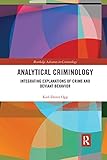Analytical Criminology : integrating explanations of crime and deviant behavior / Karl-Dieter Opp.
Material type: TextPublication details: Abingdon: New York: Routledge, 2022.Edition: First issued in paperback 2022Description: 242 Pages; 23 cmISBN:
TextPublication details: Abingdon: New York: Routledge, 2022.Edition: First issued in paperback 2022Description: 242 Pages; 23 cmISBN: - 9781032336428
- 364.3 23
- HV6018 .D565 2022
| Item type | Current library | Collection | Call number | Copy number | Status | Notes | Barcode | |
|---|---|---|---|---|---|---|---|---|
 Books
Books
|
Rabdan Academy General Stacks | General Collection | HV6018 .D565 2022 (Browse shelf(Opens below)) | C. 1 | Available | AED 241.50 | 22269 |
Browsing Rabdan Academy shelves,Shelving location: General Stacks,Collection: General Collection Close shelf browser (Hides shelf browser)

|

|

|

|

|

|

|
||
| HV6001 .P959 2022 Prisons and Prisoners : volume 51 / | HV6017 .M963 2019 The Sage Dictionary of Criminology / | HV6018 .C732 2014 Criminology Theory : a life-course approach / | HV6018 .D565 2022 Analytical Criminology : integrating explanations of crime and deviant behavior / | HV6018 .W427 2022 Research Methods for Rural Criminologists / | HV6024.5 .C193 2022 Machine Learning for Criminology and Crime Research: at the crossroads / | HV6024.5 .C663 2024 أساسيات البحث في علم الجريمة والعدالة الجنائية : علم وفن إجراء البحوث وتقييمها واستخدامها / |
Includes bibliographical references and index.
"There are more than twenty theories that explain crime. Each theory has weaknesses, and no scholar knows which theory is best. To remedy this unsatisfactory situation a new research program of comparative theory testing is proposed. Comparing the theories with each other has not yet been successful. The alternative, suggested in this book, is to show how criminological theories must be modified if they are compared with a general behavioral theory. The book shows for the major criminological theories under which conditions they provide valid explanations of crime. The latter thus become integrated as parts of the general theory. The general theory that is chosen is a version of the theory of rational action. This is not the problematic version discussed in the literature, but states the real conditions of decision making and, thus, explains when people actually violate the law or remain law-abiding. The general theory is a component of a theoretical approach that explains individual behavior in interaction with societal (macro) conditions. This micro-macro approach is summarized in a proposed structural-cognitive model. This is part of the new program of Analytical Criminology. It suggests empirical theory comparison, process explanations and micro-macro explanations. The book is not only written for readers who are interested in theories of crime and deviant behavior. It is also a treatise in "analytical" (i.e. rigorous) theory construction and empirical theory comparison"--
There are no comments on this title.
